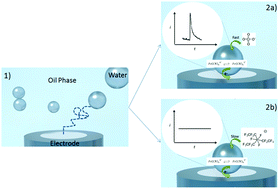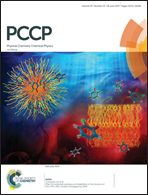Electrochemistry of single droplets of inverse (water-in-oil) emulsions†
Abstract
We demonstrate the feasibility of electrochemically detecting individual water droplets dispersed in an oil phase (inverse emulsions) via the use of a redox probe confined in the droplet phase. The water droplets were tagged with potassium ferrocyanide, and were injected into an electrolyte cyclohexene/dichloromethane oil solution. Via simple cyclic voltammetry scans it is shown that single water droplets from a water-in-oil emulsion can be detected provided that rapid anion transfer from the oil to the water phase maintains electro-neutrality in the droplet.

- This article is part of the themed collection: 2017 PCCP HOT Articles


 Please wait while we load your content...
Please wait while we load your content...